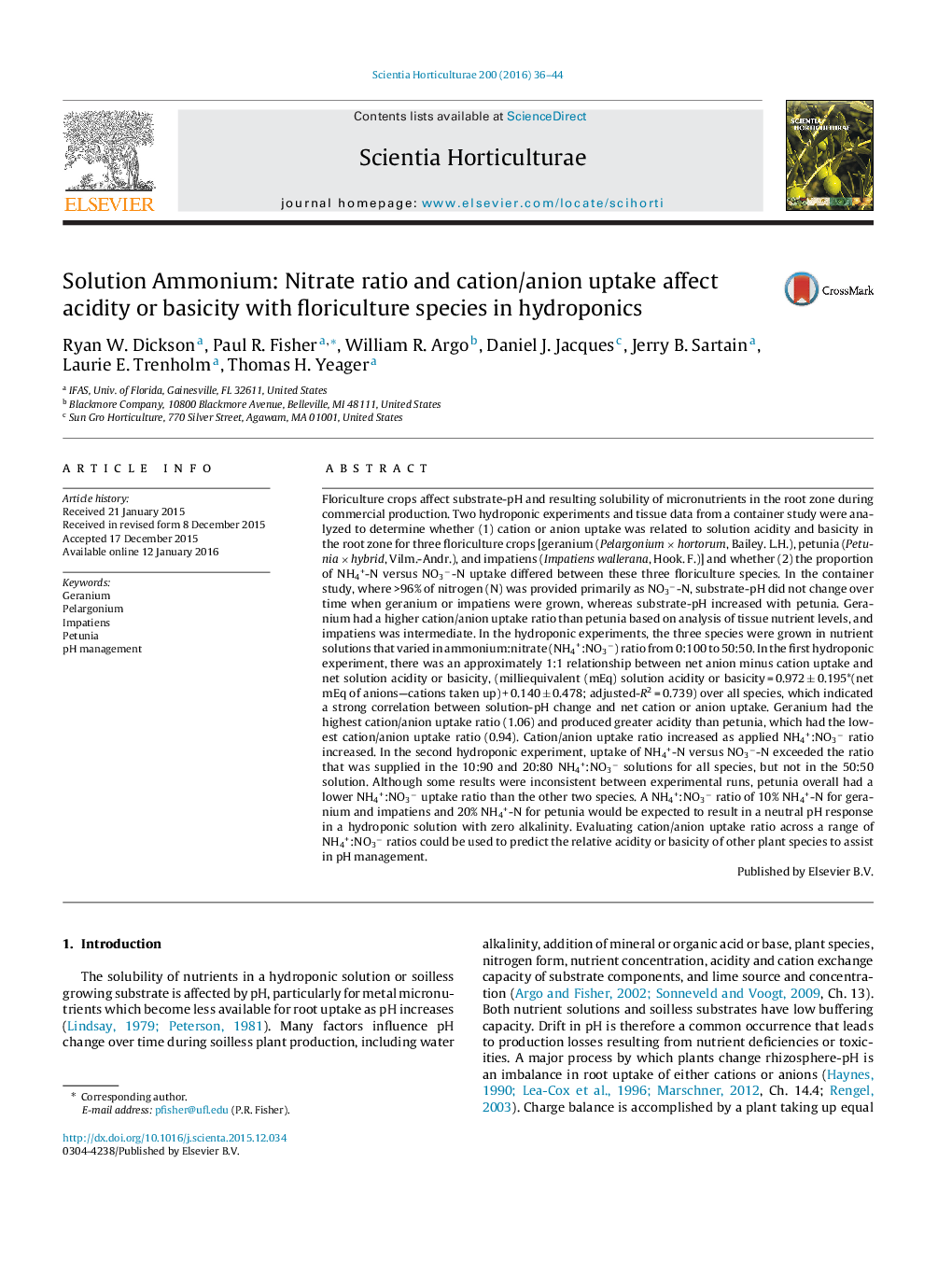| کد مقاله | کد نشریه | سال انتشار | مقاله انگلیسی | نسخه تمام متن |
|---|---|---|---|---|
| 4566056 | 1628798 | 2016 | 9 صفحه PDF | دانلود رایگان |
• Solution acidity/basicity was evaluated with hydroponic grown floriculture species.
• Net cation or anion uptake resulted in net acidity or basicity produced by roots.
• Increasing ammonium nitrogen levels increased cation uptake and solution acidity.
• Species differed in cation versus anion uptake ratios and acidity or basicity.
• Ammonium was preferred to nitrate uptake in solutions with 10% and 20% ammonium-N.
Floriculture crops affect substrate-pH and resulting solubility of micronutrients in the root zone during commercial production. Two hydroponic experiments and tissue data from a container study were analyzed to determine whether (1) cation or anion uptake was related to solution acidity and basicity in the root zone for three floriculture crops [geranium (Pelargonium × hortorum, Bailey. L.H.), petunia (Petunia × hybrid, Vilm.-Andr.), and impatiens (Impatiens wallerana, Hook. F.)] and whether (2) the proportion of NH4+-N versus NO3−-N uptake differed between these three floriculture species. In the container study, where >96% of nitrogen (N) was provided primarily as NO3−-N, substrate-pH did not change over time when geranium or impatiens were grown, whereas substrate-pH increased with petunia. Geranium had a higher cation/anion uptake ratio than petunia based on analysis of tissue nutrient levels, and impatiens was intermediate. In the hydroponic experiments, the three species were grown in nutrient solutions that varied in ammonium:nitrate (NH4+:NO3−) ratio from 0:100 to 50:50. In the first hydroponic experiment, there was an approximately 1:1 relationship between net anion minus cation uptake and net solution acidity or basicity, (milliequivalent (mEq) solution acidity or basicity = 0.972 ± 0.195*(net mEq of anions—cations taken up) + 0.140 ± 0.478; adjusted-R2 = 0.739) over all species, which indicated a strong correlation between solution-pH change and net cation or anion uptake. Geranium had the highest cation/anion uptake ratio (1.06) and produced greater acidity than petunia, which had the lowest cation/anion uptake ratio (0.94). Cation/anion uptake ratio increased as applied NH4+:NO3− ratio increased. In the second hydroponic experiment, uptake of NH4+-N versus NO3−-N exceeded the ratio that was supplied in the 10:90 and 20:80 NH4+:NO3− solutions for all species, but not in the 50:50 solution. Although some results were inconsistent between experimental runs, petunia overall had a lower NH4+:NO3− uptake ratio than the other two species. A NH4+:NO3− ratio of 10% NH4+-N for geranium and impatiens and 20% NH4+-N for petunia would be expected to result in a neutral pH response in a hydroponic solution with zero alkalinity. Evaluating cation/anion uptake ratio across a range of NH4+:NO3− ratios could be used to predict the relative acidity or basicity of other plant species to assist in pH management.
Journal: Scientia Horticulturae - Volume 200, 8 March 2016, Pages 36–44
